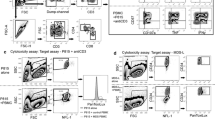Abstract
Treatment of patients in remission of acute myelocytic leukemia using immunotherapy with interleukin 2 is a new approach to prolonging remission duration in this disease. As an important mechanism for the pathophysiology of eradication of residual myelocytic blast populations, activation of cytotoxic effector lymphocytes has frequently been discussed. However, the associated immunological research has been complicated to some extent, because in conventional chromium 51-release assays, blast cells frequently fail to incorporate sufficient amounts of51Cr and/or spontaneously release high amounts of51Cr. Recently, we established a culture system which promotes the out-growth of cytotoxic T lymphocytes in bone marrow-derived mononuclear cells cultured in IL-2. To study cytotoxicity and the responsible mechanisms of the obtained T-cell lines and clones, we modified a previously described cytotoxicity assay, based on the release of lactate dehydrogenase (LDH-release assay) for use in cryopreserved blasts obtained from the bone marrow of patients with acute myelocytic leukemia. Using this assay, we were able to detect cytotoxicity of IL-2-activated peripheral blood lymphocytes from three healthy controls against a number of blast samples obtained from the bone marrow of patients with AML (up to more than 40% lysis at an effector target cell ratio of 20∶1). However, a minority of AML blasts seem to be resistant to lysis by IL-2-activated lymphocytes. In bone marrow-derived T-cell lines from patients with AML we detected lytic activity against autologous blasts in three of seven cases tested by LDH release, ranging from 29 to 63% at an effector target ratio of 10∶1. Additionally, T-cell clones with different phenotypes were established which were able to mediate cytotoxicity against autologous blast cells. Thus, cytotoxicity against freshly isolated blasts from patients with acute myelocytic leukemia can be analyzed reliably, reproducibly, and without the use of isotopes by the LDH-release assay.
Similar content being viewed by others
References
Adler A, Chervenick PA, Whiteside TL, Lotzova E, Herberman RB (1988) Interleukin 2 induction of lymphokine-activated killer (LAK) activity in the peripheral blood and bone marrow of acute leukemia patients. I. Feasibility of LAK generation in adult patients with active disease in remission. Blood 71:709–716
Adler A, Albo V, Blatt J, Whiteside TL, Herberman RB (1989) Interleukin 2 induction of lymphokine-activated killer (LAK) activity in the peripheral blood and bone marrow of acute leukemia patients. II. Feasibility of LAK generation in children with active disease and in remission. Blood 74:1690–1697
Archimbaud E, Bailly M, Dore JF (1991) Inducibility of lymphokine-activated killer (LAK) cells in patients with acute myelogenous leukemia in complete remission and its clinical relevance. Br J Heamatol 77:328–335
Bergmann L, Fenchel K, Weidmann E, Enzinger HM, Jahn B, Jonas D, Mitrou PS (1993) Daily alternating administration of high-dose alpha-2b-interferon and interleukin 2 bolus infusion in metastatic renal cell cancer. A phase-II study. Cancer 72:1733–1742
Bergmann L, Heil G, Kolbe K, Lengfelder E, Puzicha E, Martin H, J, Lohmeyer J, Mitrou PS, Hoelzer D (1994) Interleukin 2 bolus infusion as late consolidation therapy in 2nd remission of acute myelocytic leukemia. Leukemia Lymphoma (in press)
Foa R (1993) Does interleukin 2 have a role in the management of acute leukemia? J Clin Oncol 11:1817–1825
Foa R, Guarini A, Tos GA, Cardona S, Fierro MT, Meloni T, Tosti S, Mandelli F, Gavosto F (1991) Peripheral blood and bone marrow immunophenotypic and functional modifications induced in acute leukemia patients treated with interleukin 2: evidence of in vivo lymphokine-activated killer cell generation. Cancer Res 51:964–968
Fuchshuber PR, Lotzova E, Savary CA (1992) Generation of MHC non-restricted and restricted oncolytic subsets from human bone marrow. Cell Immunol 139:30–37
Jahn B, Bergmann L, Weidmann E, Brieger J, Fenchel K, Schwulera U, Hoelzer D, Mitrou PS (1994) Bone marrow-derived T-cell clones obtained from untreated acute myelocytics leukemia exhibit autologous cytotoxicity. Leukemia Res (in press)
Korzeniewski C, Callewaert DM (1983) An enzyme-release assay for natural cytotoxicity. J Immunol Methods 64:313–320
Parkinson DR (1988) Interleukin 2 in cancer therapy. Semin Oncol 15:10–26
Pross HF, Baines MT, Rubin P, Shragge P, Petterson MS (1981) Spontaneous human lymphocyte cytotoxicity against human tumor target cells. IX. The quantitation of human natural killer cell activity. J Clin Immunol 1:51–63
Rosenberg SA, Lotze MT, Muul ML, Chang AE, Avis FP, Leitmann S, Linehan M, Robertson CG, White DE (1987) A progress report on 157 patients with advanced cancer using lymphokine-activated killer cells and interleukin 2 or highdose interleukin 2 alone. N Engl J Med 316:889–897
Shimizu S, Weidmann E, Iwatsuki S, Herberman RB, Whiteside TL (1991) Characterization of human auto-reactive T-cell clones obtained from tumor-infiltrating lymphocytes in liver metastases of gastric carcinoma. Cancer Res 51:6153–6160
Weidmann E, Bergmann L, Stock J, Kirsten R, Mitrou PS (1992) Rapid cytokine release in patients treated with interleukin 2. J Immunother 12:123–131
Weidmann E, Whiteside TL, Giorda R, Herberman RB, Trucco M (1992) The T-cell receptor Vβ chain usage in tumor-infiltrating lymphocytes and blood of patients with hepatocellular carcinoma. Cancer Res 52:5913–5920
Weidmann E, Elder EM, Trucco M, Lotze MT, Whiteside TL (1993) Usage of T-cell receptor Vβ chain genes in fresh and cultured tumor-infiltrating lymphocytes from human melanoma. Int J Cancer 54:383–390
West WH, Tauer KW, Yanelli JR, Marshall GD, Orr DW, Thurman GB, Oldham RK (1987) Constant-infusion recombinant interleukin 2 in adoptive immunotherapy of advanced cancer. N Engl J Med 316: 898–905
Author information
Authors and Affiliations
Additional information
The present study was supported by theDeutsche Krebshilfe (Grant No.: W22/92 Bel), and theAdolf-Messer-Stiftung
Rights and permissions
About this article
Cite this article
Weidmann, E., Brieger, J., Jahn, B. et al. Lactate dehydrogenase-release assay: A reliable, nonradioactive technique for analysis of cytotoxic lymphocyte-mediated lytic activity against blasts from acute myelocytic leukemia. Ann Hematol 70, 153–158 (1995). https://doi.org/10.1007/BF01682036
Received:
Accepted:
Issue Date:
DOI: https://doi.org/10.1007/BF01682036




